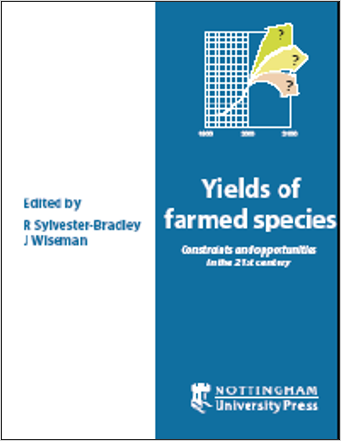Yields of Farmed Species: Constraints and Opportunities in the 21st Century

Book edited by Roger Sylvester-Bradley and Julian Wiseman exploring the potential for yield improvements in a range of crops, grasss and livestock. Proceedings of Nottingham University Easter School 2004.
Synopsis
Can we expect the dramatic yield increases of the last century to continue? What are the yield potentials of the species which are farmed now? How will new technologies affect yields achieved in future decades? To what extent will pests, pathogens, competing demands for resources, or scruples about farming processes, curtail our ability to innovate in the production of food? Solutions to these and other issues are debated in this volume.
Output from 2006 Defra project ISO210 (CTE0207) Yields of UK crops and livestock: physiological and technological constraints and expectations of progress to 2050
Summary from Defra report:
Background
Yields of crops and livestock fundamentally affect government policies, environmental impacts and the economics of farming. This study provides information on how agricultural yields may change through to 2050. The rapid increases in UK farm yields over the last few decades are well recognised, but continuing increases cannot be presumed. Increases are attributed in large part to the plant and animal breeding, to better husbandry systems, and to chemical protection and nutrition. Further increases will depend on yield potentials of each farmed species in the UK environment, and the extent to which new technology can move yields towards these potentials. There have been suggestions that rates of increase in yields have slowed in recent years. This project estimates whether yield potentials are now being approached or whether there are technological constraints on progress.
Objectives
The aims of this Project were:
- To form initial estimates, based on literature and data to hand, of the yield potentials of the major species farmed in the UK according to physiological and technological considerations.
- To collate and publish, through an International Conference, what extant views were on likely progress in on-farm yields of livestock and crops through to 2050.
- To review and report to Defra the best consensus on yield potentials of the major crops and livestock farmed in the UK, along with the main factors expected to affect progress in yield through to 2050.
Approaches
Case studies were carried out for nine major farm species: wheat, oilseed rape, peas, potatoes, grass, milk, beef & sheep, pigs and poultry. For each species, experts were chosen to estimate potential yield, predict progress towards this and identify the most likely constraints. Particular attention was paid to the potential negative effects of continued yield improvement. Scenarios of changes to conditions for farming in 2010, 2020 and 2050, which were developed under parallel project IS0209, were used to assess the rate of yield improvement under different futures. These studies, along with generic issues relating to yield, were presented to 60 agricultural scientists at the International Conference ‘Yields of Farmed Species’ in June 2004 held at the University of Nottingham Sutton Bonington Campus. The authors of the case studies were able to incorporate feedback arising from the main presentation and the workshop session that focussed on the detail of the calculations used. The revised case studies, representing a consensus of an international group of scientists, were then collated and integrated in this report, with predictions expressed in common terms. The conference proceedings were published as a 600 page hard-back book. The book provides the evidence and rationale for the yield predictions set out in this report; references to specific pages of the proceedings are provided throughout.
Summary of Results
Potential yields
It is important that units for yield are defined. In this project yields were calculated on an annual basis and where necessary accounted for animal growth rate and fecundity. The units used for crops are t/ha/yr and the units used for animal species include: milk (l/cow/yr), beef and poultry (kg live weight/animal/yr), eggs (eggs/bird/yr), pigs and sheep (kg of offspring/dam/yr). Current farm yields are significantly below the estimated potential yields. When farm yields are expressed as a proportion of the unirrigated potential the farm species are ranked as follows; eggs (0.82), poultry meat (0.81), potatoes (0.66), pigs (0.56), beef (0.53), peas (0.45), wheat (0.44), oilseed rape (0.38), sheep (0.27), grass (0.27) and milk (0.22). These estimates assume that crops will be able to use almost all of the annual rainfall. If the irrigated yield potential is used for estimating the potential yield of potatoes then the ratio of farm yield to potential yield decreases to 0.33. If potential yields could be achieved then the crop area required to produce each unit of livestock production would decrease by between two- and four-fold. Climate change is predicted to have a relatively minor effect on potential yield under rainfed conditions because positive effects of greater CO2 and, to a certain extent, higher temperatures, will largely offset effects of less summer rainfall and greater potential evapo-transpiration. In an irrigated environment the potential yield of potatoes may rise by >20% by 2050.
Constraints for achieving potential yields
Constraints for achieving potential yield can be split into 1) the development of new technology for increasing yield and 2) uptake of existing and new technology by practitioners. On balance it appears that technology uptake will be the most important constraint. For example, the gap between research yields and farm yields is widening for oilseed rape, probably because decreasing commodity prices reduce the economic optimum level of inputs, and reduce the incentive for farmers to invest in technology.
Increasing environmental regulation to reduce pollution and increase biodiversity, social concerns about technologies such as genetic modification, and refocusing market requirements towards free range animal produce and quality (e.g. potatoes) will also restrict the uptake of technologies for maximising yields. Only some of these objectives are incompatible with high yields, e.g. higher yielding animals produce less pollution per unit of produce, waste management and pollution is easier to control for housed livestock and biodiversity can be improved by careful management of non-cropped areas.
To an extent, the development of new technologies is less constrained than its uptake because some innovation takes place outside agriculture, global companies are buffered against fluctuating regional demands for their products, and research institutes and universities are often centrally funded and less influenced by market forces (at least in the short to medium term). Development of new germplasm is however a potential constraint. Plant and animal breeders have consistently increased yields for several decades but several factors now pose a threat. In particular, as yields approach species’ potentials, breeders will increasingly encounter and need to overcome traits that have negative associations with yields (crop stability, reproductive performance, metabolic stress, immunity to disease and functional fitness), whilst political pressures for greater sustainability will demand greater pest resistance and greater resource use efficiency. Diminishing returns that are ultimately linked with low commodity prices, may also slow the rate of breeding progress (as has already occurred with peas and beans).
Estimates of future yields under different scenarios
IS0209 constructed four scenarios to span the range of possible UK futures; World Market (free trade), Global Sustainability (internationally competitive, moderated by environmental compliance), National Enterprise (protected domestic markets), Local Stewardship (emphasis on environmental objectives). A future ‘business as usual’ scenario was added to represent extrapolation of recent trends. In order to assess future yields under each scenario, a matrix of indicators considered to influence farm yields was drawn up by this study and IS0209. Factors predicted to have the greatest positive effect on farm yields included commodity ‘farm gate’ prices and the cost of farm inputs (including management). The most negative factors included environmental regulation as it constrains the levels of inputs. Under the Business As Usual scenario recent yield trends are predicted to continue with wheat yields increasing at 1% per year, the carcass weights of cattle, sheep, pigs and poultry will increase by 0.5% per year, eggs/bird/year and milk/cow/year will increase at 0.5% per year and no increase will occur for oilseed rape, peas, potatoes and grass. In the short-term, yields may appear to increase as production becomes focused on high yielding land (due to decoupling of farm subsidies from production). However, in the medium term the consensus amongst experts was that environmental regulation, weakening economic signals and increasingly diverse breeding targets will slow the rate of yield improvement.
Considering other futures, greatest yield improvements are expected under the National Enterprise and World Market scenarios. Under National Enterprise, high commodity prices, medium input costs and low environmental regulation enable a high level of innovation and inputs. Predicted yield increases under this scenario by 2050 are 20 to 80%. Under a World Market scenario yield improvement of up to 60% is expected due to lower input prices, less environmental regulation and the abandonment of less productive land. Yields are expected to remain static or rise slightly under a Global Sustainability scenario and to remain static or fall by up to 25% under a Local Stewardship scenario due to the high level of regulation and lower inputs.
Discussion
On a global scale, improvement of farm yields is just one of several means by which an increasing population may be provided with adequate nutrition, fuel, clothing and building materials. Other means include (1) extension of farming, by claiming natural habitat, (2) reducing wastage, e.g. 15% cereal production is wasted (p13), (3) reducing over consumption and (4) using more efficient species, e.g. fish are 8 times more efficient producing protein from plant material than cattle (p14). On a regional scale, IS0209 illustrated that yield estimates are a key factor for predicting land uses and environmental impacts. UK land required for agricultural production was predicted to decrease under Business As Usual, World Market and Global Sustainability scenarios. These changes were mainly due to greater yields and competition from imports. By contrast insufficient land would be available to meet demand under the Global Sustainability and Local Stewardship scenarios as a result of lower yields and greater local demand for produce. The overall environmental load produced by agriculture is predicted to be least under World Market and Business As Usual scenarios. This is due to the large amount of land released from agricultural production, although the burden is high in the areas that are farmed intensively. Yield estimates also affect the prediction of economic factors and social factors such as the amount of land available for recreation.
Implications for Defra Priorities
There is considerable scope to further increase yield of all species within the constraints of the UK environment and thereby food and fuel security could increase, imports could be reduced, and environmental costs could be curtailed. Realising potential yields would significantly reduce the amount of agricultural land required to produce each unit of crop and livestock product (by as much as 4-fold), thus land could potentially be released for non-agricultural uses. Project IS0209 predicted this would have significant and positive effects on the environment. However, under current economic and political environments it seems unlikely that the industry will be able to exploit this advantage, because high costs, low commodity prices, environmental regulation and social issues will all tend to restrict development and exploitation of new and existing technologies for increasing yields.

